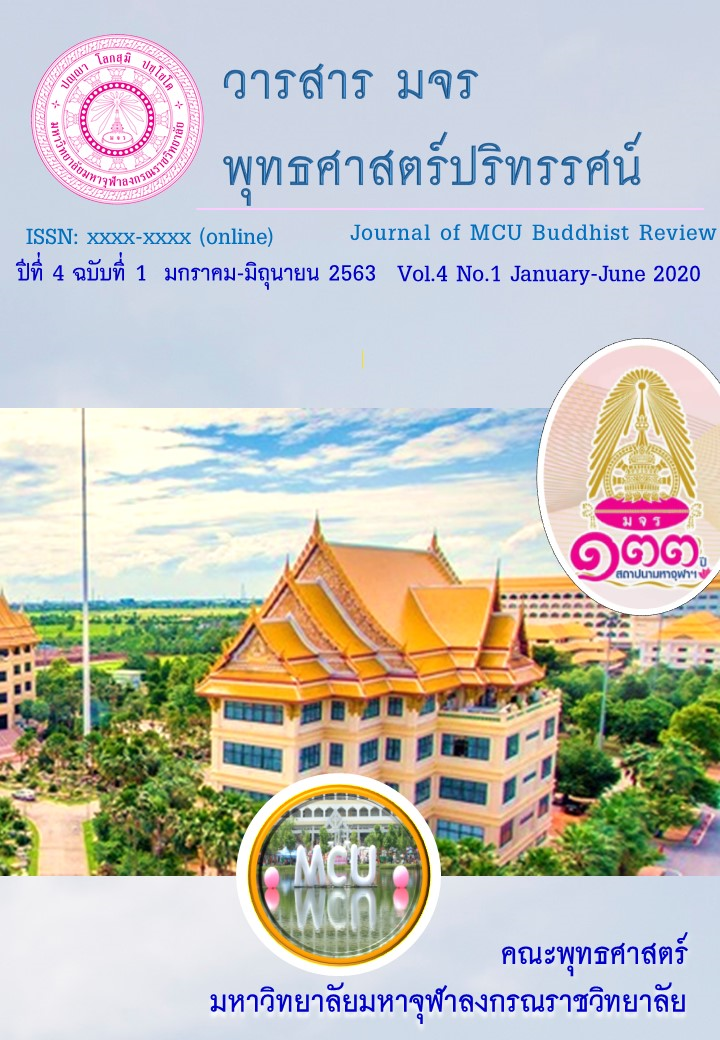การตีความคำสอนเรื่องอิทัปปัจจยตาในทัศนะของพุทธทาสภิกขุ การตีความ, อิทัปปัจจยตา, พุทธทาสภิกขุ
Main Article Content
บทคัดย่อ
บทความนี้เป็นการศึกษาการตีความคำสอนเรื่องอิทัปปัจจยตาของพุทธทาสภิกขุ มีวัตถุประสงค์การศึกษาคือ ๑) เพื่อศึกษาแนวคิดเรื่องอิทัปปัจจยตาในพระพุทธศาสนา และ ๒) เพื่อศึกษาการตีความคำสอนเรื่องอิทัปปจยตาของพุทธทาสภิกขุ จากการศึกษาพบว่า อิทัปปัจจยตา เป็นหลักธรรมที่มีความสำคัญเรื่องหนึ่งในพระพุทธศาสนา เป็นหลักคำสอนที่อธิบายเรื่องกฎธรรมชาติ ที่เกี่ยวเนื่องกับเรื่องความจริงและเรื่องของชีวิตหัวใจสำคัญของอิทัปปัจจยตาคือ การที่สิ่งนี้ ๆ เป็นปัจจัย จึงมีสิ่งนี้เกิดขึ้น หรือเป็นสิ่งที่อธิบายความเกิดดับของสรรพสิ่ง พุทธทาสภิกขุตีความคำสอนเรื่องอิทัปปัจจยตาไว้ ๒ ลักษณะคือ ๑) ในลักษณะสัจธรรม คือมองว่า อิทัปปัจจยตา มีลักษณะเหมือนปฐมเหตุของสรรพสิ่ง สรรพสิ่งล้วนอยู่ภายใต้กฎเดียวกันคืออิทัปปัจจยตา หรือกล่าวอีกนัยหนึ่ง คืออิทัปปัจจยตาเป็นพระเจ้าในความหมายว่า เป็นต้นกำเนิด คอยควบคุมสรรพสิ่ง ๒) ในลักษณะที่เป็นจริยธรรม คือมองว่าคำสอนเรื่องอิทัปปัจจยตา สามารถนำมาปฏิบัติในชีวิตประจำวันได้ เน้นให้เกิดประโยชน์ในการปฏิบัติชีวิตประจำวันเป็นสำคัญ
Article Details
- บทความที่ได้รับการตีพิมพ์เป็นลิขสิทธิ์ของวารสาร มจร พุทธศาสตร์ปริทรรศน์
- ข้อความใดๆ ที่ปรากฎในบทความที่ได้รับการตีพิมพ์ในวารสาร ถือเป็นความรับผิดชอบของผู้เขียนบทความ และข้อคิดเห็นนั้นไม่ถือว่าเป็นทัศนะและความรับผิดชอบของกองบรรณาธิการวารสาร มจร พุทธศาสตร์ปริทรรศน์
เอกสารอ้างอิง
มหาวิทยาลัยมหาจุฬาลงกรณราชวิทยาลัย. พระไตรปิฎกภาษาไทย ฉบับมหาจุฬาลงกรณราชวิทยาลัย. กรุงเทพมหานคร : โรงพิมพ์มหาจุฬาลงกรณราชวิทยาลัย, ๒๕๓๙.
กระทรวงศึกษาธิการ. หนังสือเรียนวิชาชีววิทยา ว 042. กรุงเทพมหานคร : คุรุสภา, ๒๕๓๕.
ธ.ธรรมศรี. พุทธมนต์พิธี. กรุงเทพมหานคร : โรงพิมพ์เลี่ยงเชียง, มปพ.
พุทธทาสภิกขุ. อิทัปปัจจยตา. กรุงเทพมหานคร : สำนักพิมพ์สุขภาพใจ, ๒๕๔๔.
วัชระ งามจิตรเจริญ. พระพุทธศาสนาเถรวาท. กรุงเทพมหานคร ฯ : บัณฑิตวิทยาลัยมหาวิทยาลัยธรรมศาสตร์, ๒๕๔๕.


